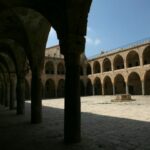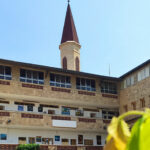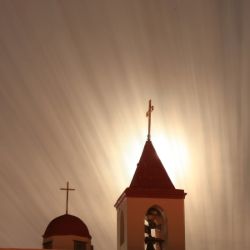Discover the ancient khans that served traveling merchants.
In Old Akko 4 Khans. The largest of which is Khan al-Umdan (Khan of the Pillars) adjacent to the port and was formerly used by the merchants who came to Akko from all over the world. The khan is about to become a boutique hotel while preserving its unique ancient structure. The other three khans: Khan a-Shwarda, Khan al-Franj, Khan a-Shuna.
Khan Al-Umdan
Khan al-Umdan is a large merchant’s inn adjacent to the port which was used for international trade. Merchants who arrived to the port unloaded their goods in the inn’s storerooms on the first floor and slept in the rooms on the second floor, which constituted a unique hotel.
The khan was built in the late 18th century by Ahmed al-Jazzar and it rests on a row of granite pillars brought from various sites in the area.
The khan’s courtyard can be viewed partially from the outside.
Khan a-Shawarda
Khan a-Shawarda (the Merchants’ Inn) was most probably built by Daher al-Omar in the 18th century. It has a square courtyard with the remains of a watering trough for livestock in its center.
During the British Mandate, openings were made in the khan’s courtyard from the north and the south in order to facilitate traffic. It is believed to be the site of a Clarissan Nuns convent dating back to the Crusader Period. History has it that when the Moslems took over the city, the nuns deliberately mutilated themselves by cutting off their noses so as not to surrender to the conquerors (Mondril made reference to this in 1697).
Khan Al-Shuna
Acre’s oldest inn – Khan al-Shuna (the Granary Inn) – still stands about 30 meters northeast of Khan Al-Umdan. An Arabic inscription at the gate describes its renovation and reparation during the days of Daher al-Omar.
The inn’s uniqueness lies in the fact that large sections of the building – primarily the ground floor – date back to the Crusader Period.
Khan El-Franj
Khan el-Franj was built in the mid-16th century by French merchants in an area that served as the central courtyard of the Venetian quarter during the Crusader Period.
This is Akko’s oldest remaining khan. It is named after the French merchants who built and lived in it. The French merchants’ activity in Akko reached its peak in the late 18th century, until they were banished from the city by Jazzar Pasha in 1791.
After their banishment, Pasha took over the cotton trade, which the French had thus far had a virtually monopolistic hold over.
In the early 18th century, the Governor of Akko lived at the Khan el-Franj; he had moved there for reasons of security, so as to be able to keep a watchful eye on the French merchants and collect taxes from them more efficiently.
One of the khan’s wings currently houses a school. The khan’s courtyard is open to the public.












